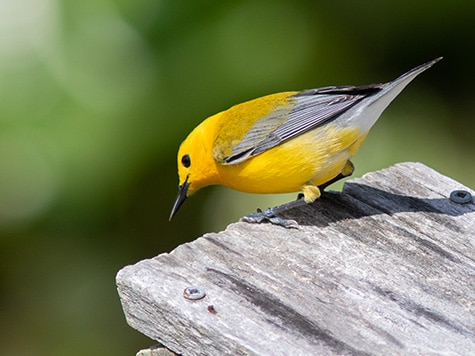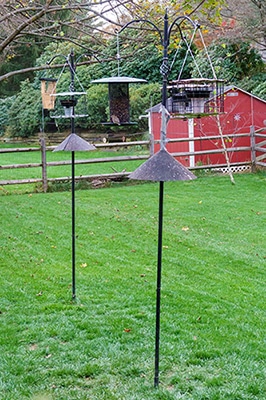Practical Tips for Birding
Practical Tips: What do I need for birding?
 The basics are your eyes, ears, and a willingness to enjoy and learn.
The basics are your eyes, ears, and a willingness to enjoy and learn.
Equipment:
Most birders carry binoculars to help them see birds. These optics also serve as a “necklace” that identifies them to fellow birders who may ask, “See anything?” as they encounter each other in the field.
An internet search will provide recommendations for specific birding binoculars in various price ranges. Binocular specifications are generally based on two numbers, such as 8×42 or 10×32. A basic rule of thumb for birding binoculars is to choose binoculars with the first number (the magnification power) between 8 and 10 and the second number (the size of the objective lens—the glass at the end of the binoculars that is pointed toward the birds) between 30 and 42 millimeters.
Factors such as special lens coating, weight, and ability to transmit light all affect the price of binoculars.
Locally, you can try out and buy binoculars in person at the Nature Forward’s nature shop in Chevy Chase and at some brick-and-mortar photo stores. Some online retailers will allow you to purchase several pairs and return the ones you don’t want. Be sure to select binoculars that you can hold steady (no magnification over 10x) and that fit your hands and eyes so you can see through them and adjust them easily. When in the field, many birders wear a binocular harness to distribute the weight of optics over the shoulders for all-day comfort rather than use a neck strap.
Check out this YouTube video on how to use binoculars and PRACTICE.
A bird field guide—as an app for your phone (easier to carry) or as a book (easier to read and with bigger pictures)—is essential for birders. Recommended are The Sibley Field Guide to Birds of Eastern North America, 2nd edition (book and app); National Geographic Field Guide to the Birds of North America, 7th edition (book); and Merlin Bird ID app.
Options:
Some birders carry cameras to record their sightings. Others have spotting scopes to get good looks at far-away and slowly moving birds such as waterfowl.
Outdoor Readiness:
A bottle of water is a must year-round and a hat that shades the eyes is extremely helpful. Protection from sun and, in warmer weather, from insects is recommended—sunscreen, sunglasses, long-sleeve shirt, long pants, bug spray, or clothes (especially socks) that have been treated with permethrin. Wear sturdy comfortable shoes. Waterproof boots are helpful in wet weather and muddy conditions. Several layers of clothing covered with wind-resistant outerwear work best in cold weather. Hand and foot warmers can be useful too.
Choosing time, locations, and days:
Birds are most active in the morning when they’re ready to feed and near sunset when they settle in for the night.
Check out these recommended sites in Montgomery County. Also, eBird hotspot records suggest, but do not guarantee, what you can see where and when.
Know that many public areas are open to hunting in colder months. Wear red or neon colors for safety if you opt to bird at these sites during the hunting season. Check out this calendar for Maryland lands: https://dnr.maryland.gov/huntersguide/Documents/Hunting_Seasons_Calendar.pdf
Montgomery Bird Club Walks:
Learn from experienced leaders and your fellow club members. Click Here to view our club calendar.
Feeders:
Feeding birds can be a wonderful experience. Whether you have a single feeder or many, seed and suet provide birds with a reliable and sustainable source of food. Below are several links to information on feeders:
- All About Birds: General Information: https://www.allaboutbirds.org/news/browse/topic/feeding-birds/
- Audubon Society Tips: https://www.audubon.org/news/11-tips-feeding-backyard-birds
- Bird Watcher’s Digest: Feeding Tips: https://bwdmagazine.com/backyard-birding/#bird-feeding-tips
- National Wildlife Federation: General https://blog.nwf.org/2011/05/a-beginners-guide-to-backyard-bird-feeding/
- The Spruce: Feeding Mistakes https://www.thespruce.com/top-bird-feeding-mistakes-386614
- All About Birds: Where to Put Feeders https://www.allaboutbirds.org/news/where-to-put-your-bird-feeder/
- All About Birds: How to Choose the Right Feeder https://www.allaboutbirds.org/news/how-to-choose-the-right-kind-of-bird-feeder/
 In addition, battling squirrels can be a huge issue when feeding birds. Squirrels can get to your feeder and eat all the food leaving the birds without any. Montgomery Bird Club member Scott Young recommends the following:
In addition, battling squirrels can be a huge issue when feeding birds. Squirrels can get to your feeder and eat all the food leaving the birds without any. Montgomery Bird Club member Scott Young recommends the following:
- Since squirrels can jump up to five feet, place a “cone” on the pole at five feet.
- Place your feeders and poles at least six feet away from the nearest shrubbery
- Do not place your feeders below a tree
Scott’s yard is pictured depicting the strategy he is using to defeat squirrels:
eBIRD:
Many birders record their sightings on eBird, a website operated by the Cornell University Laboratory of Ornithology. It allows birders to share their checklists of birds and keep life, county, state, and year lists easily. Cornell archives the data and shares it for use in science, conservation, and education. Find out more here: https://ebird.org/about
Other Options:
Like and follow the Montgomery Bird Club Facebook page: https://www.facebook.com/MontgomeryBirdClub/
Join the Google group for sharing information about sightings of rare birds in Maryland and the District of Columbia: https://groups.google.com/g/mdbirding
Follow the Facebook group Maryland Notable Bird Sighting and Discussion Group: https://www.facebook.com/groups/MDRareBirdsDiscussionGroup/
Take an online course in bird identification at Cornell’s Bird Academy: https://academy.allaboutbirds.org/
Learn to identify birds by their songs via apps such as Larkwire. Search in the iPhone App Store or in Google Play. CDs also work for learning songs, especially the classic Birding by Ear: Eastern/Central (Peterson Field Guides). Cornell’s Bird Academy has an online class in bird song ID.
Explore birding topics on YouTube. Start with “Birds of North America.”
Search for and follow podcasts on birding — there are dozens. Try the American Birding Association’s podcast and “Hannah and Erik Go Birding.”
Become a member of the American Birding Association, which comes with a subscription to Birding magazine.
Subscribe to magazines aimed at birders, such as Bird Watchers Digest and BirdWatching.


